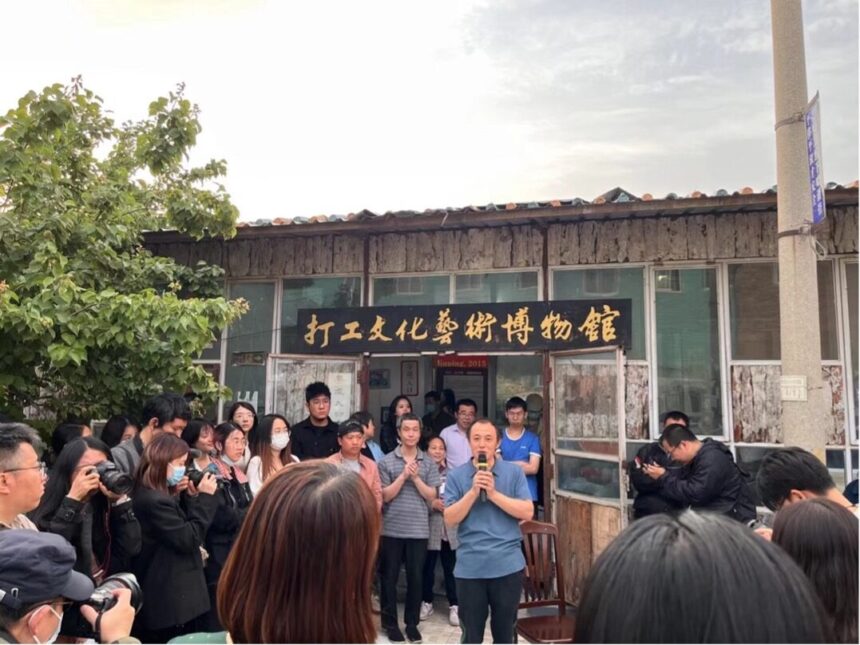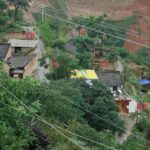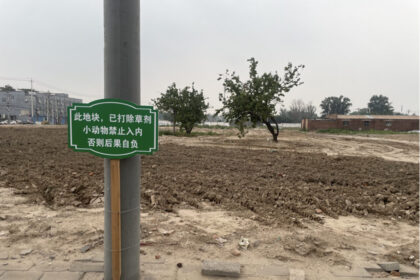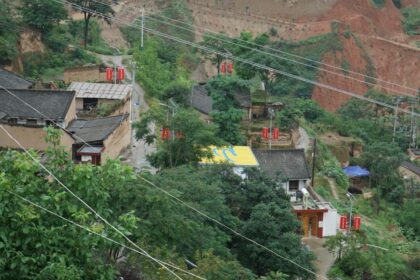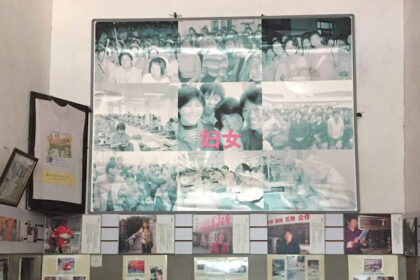Picun as a Nearby
Yuxiang Dong
On May 20, 2023, a group of migrant workers, journalists, and students gathered in a courtyard in Picun to bid farewell to the dagong wenhua yishu bowuguan (打工文化艺术博物馆 Culture and Art Museum of Migrant Workers). In the center of the crowd, Wang Dezhi (王德志) hosted the farewell party and people took turns to read poems, sing songs, and share their personal stories with the museum and Picun (皮村). The museum, originally an abandoned factory workshop, opened to the public on the 2008 International Workers’ Day after being renovated and was recently ordered to be demolished due to urban planning. Picun is a small village in the outer fringes of Beijing, located outside the fifth Ring Road, seven kilometers away from the Beijing Capital International Airport. Based on research and reports from the 2010s, between one and three thousand of Picun’s population are locally registered, and ten to thirty thousand are migrants. [1] Situated within a major migrant worker community, the Culture and Art Museum of Migrant Workers was founded and run by a group of migrant workers to regain subjectivity in the history-making of the country’s postsocialist reforms through commemorating the cruelties of displacement, workplace injury, left-behind children, and civil rights issues for migrant workers under the economic miracle in the past decades.
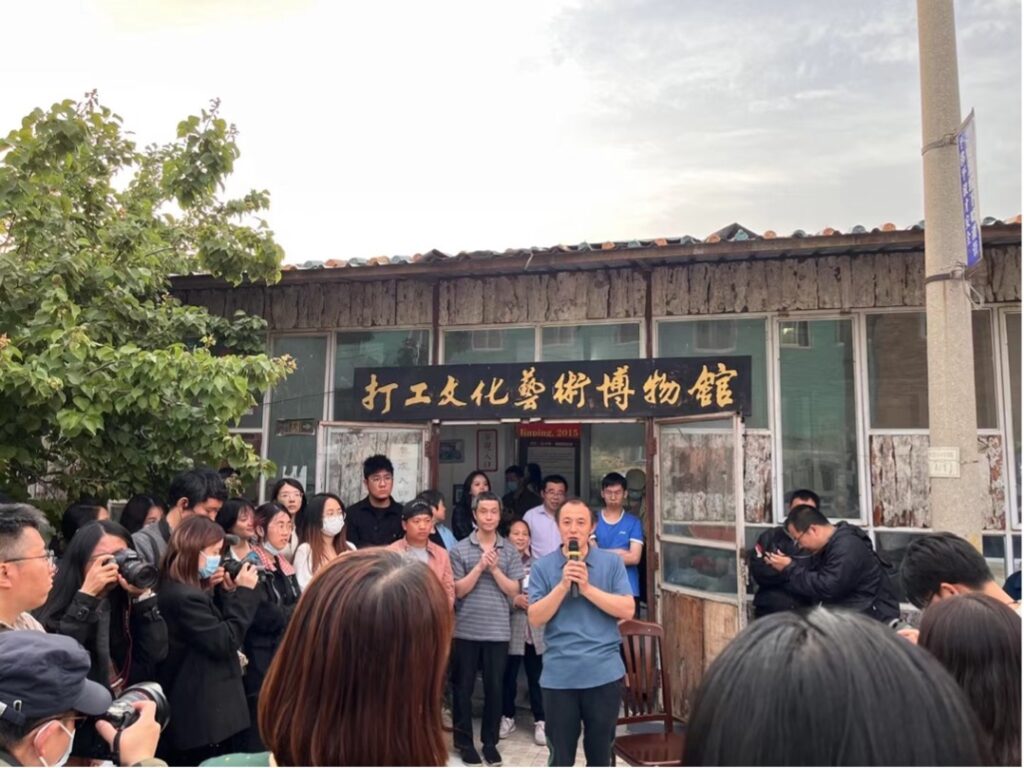
The core members of this group of migrant workers who founded and operated the Culture and Art Museum of Migrant Workers include Sun Heng (孙恒), Xu Duo (许多), and Wang Dezhi. In 1995, Wang migrated to Beijing from Inner Mongolia and dreamed of performing on the stage of the Spring Festival Gala at China Central Television (CCTV). But he was rejected and ended up working in restaurants and factories. Sun taught music in a middle school in his hometown Kaifeng, Henan Province, but he resigned and moved to Beijing in 1998. After living in the capital for a year, Sun started his traveling performance throughout the country. After graduating from high school, Xu was arranged by his family to work as auxiliary police in Hangzhou, Zhejiang Province. However, he gave up the job and studied rock music in Beijing Midi School of Music in 1999. On May 1, 2002—International Workers’ Day—after a performance for migrant workers, Sun, Wang, and Xu decided to form an art group based on their shared interest in art called the dagong qingnian wenyi yanchudui (打工青年文艺演出队, Performance Team of Young Migrant Workers). The group’s mission is “yong gesheng nahan yi wenyi weiquan (用歌声呐喊以文艺维权, to shout with music, to defend rights with art).” During their performances, the group encountered many practical problems of migrant workers like loneliness, civil rights issues, among others, which were beyond the ability of an art group to deal with. Thus in November 2002, at the suggestion of activist and scholar friends, they founded the non-governmental organization nongyou zhijia (农友之家, Peasants Home). In spring 2003, as members of the performance team grew, the name was changed to dagong qingnian yishutuan (打工青年艺术团, Young Migrant Workers Art Troupe). In 2006, they renamed the art group xingongren yishutuan (新工人艺术团, New Workers Art Troupe) and the NGO gongyou zhijia (工友之家, Migrant Workers Home). In 2018, the New Worker Art Troupe changed their name to xingongren yishutuan (新工人乐团, New Workers Band), owing to their focus on music.
In this essay, I will first introduce the social and art practices of the New Workers Band and the Migrant Workers Home in Picun, also discussing related academic research to illustrate what Picun is from different perspectives. In order to critically acknowledge the distance between Migrant Workers Home, the village of Picun, and my research due to physical distance, life experience, and social status, I conceptualize Picun as a nearby, a method proposed by Xiang Biao (项飙). [2] I argue that Migrant Workers Home cannot represent Picun and the method of Picun as a nearby is fluid and generative and challenges the methodological dominance of symptomatic reading, which can be problematic for socially engaged art criticism. Furthermore, based on my experience of conducting a series of interviews with migrant workers, scholars, artists/curators for this issue of Field, I claim that we just speak nearby, a concept conceived by Trinh T. Minh-ha, to open more space for new workers to consider beyond the homogeneous and orthodoxic discourse of socialist revolution and for researchers to write socially engaged art criticism. [3] Finally, I conclude this essay by claiming a vision of the near future that shifts the focus from the great emancipation of the working class to the emergence of concrete sociality and accessible consequential collective actions.
What is Picun?
In 2005, the then Young Migrant Workers Art Troupe and Peasants Home settled in Picun, a major migrant worker community in Beijing’s rural-urban fringes. They used the royalties from their first album tianxia dagong shi yijia (天下打工是一家, We Migrant Workers Are a Family) to start the tongxin shiyan xuexiao (同心实验学校, Tongxin Experimental School) for migrants’ children in Picun. Since then, they have engaged with placemaking in their art and social practices with a sensibility towards local cultural and spatial specificities of the rural-urban fringe to establish the substance for migrant workers. Their major initiatives include: tongxin huhui gongyi shangdian (同心互惠公益商店, Tongxin Mutual Aid Charity Store), a social enterprise established in 2006; the Culture and Art Museum of Migrant Workers; xingongren wenhua yishujie (新工人文化艺术节, Culture and Art Festival of New Workers), an annual festival featuring music, theater, film, and art by and for workers from 2009 to 2011; and dagong chunwan(打工春晚, Spring Festival Gala for Migrant Workers), a nationwide cultural platform for the workers held between 2012 and 2017. They are also active on Weibo, WeChat, TikTok, Kwai, and other social media platforms. These practices are all critical approaches for them to mobilize laborers, raise debates in intellectual circles, and catch media attention. Instead of being depicted, represented, or engaged, Picun’s workers regained their subjectivity through cultural productions to construct the collective identity of xingongren (新工人, new workers) and spread xingongren wenhua (新工人文化, new workers culture).
From the Youth Performance Team of Migrant Workers to the New Workers Band, music is always at the heart of the group’s practices, which has already attracted considerable scholarly attention. Meanwhile, in recent years, the picun wenxue xiaozu (皮村文学小组, Picun Literature Group)–another initiative of the Migrant Workers Home since 2014–has also attracted significant attention not only among scholars but also popular media. This is well illustrated by Fan Yusu’s (范雨素) autobiographic essay “Wo Shi Fan Yusu” (我是范雨素, I am Fan Yusu) going viral. Fan is a migrant worker, live-in nanny, and member of the Picun Literature Group. The analyses of this literature group emphasize the self-consciousness in seeking and negotiating their collective identity and position in the social structure of post-socialist neoliberalism, which catalyzed the collective identity of new workers and the rise of new workers’ culture. [4] Compared to traditional workers at state-owned factories who are treated and controlled by their bianzhi (编制, status) in danwei (单位, working units) throughout their lives, new workers have more career choices and mobility but, at the same time, they suffer from uncertainty and instability. The term “migrant workers” usually means manual laborers who move from rural to urban areas and are restricted from having equal civil rights as urban residents. They are not the proletariat, since most of them may have a piece of land at home in the countryside, inheriting the land relations established in the socialist period. [5]
However, many new workers, a younger generation of laborers, are born and raised in cities and towns; the majority of them have rarely lived in villages or engaged in agricultural productions. They consider themselves urban residents rather than migrants who will eventually return to the countryside, but they are still prevented from having equal civil rights in the cities. The local governments of their registered households have also stopped granting them any land allocation. Thus, new workers, a new collective consciousness of the proletariat formed in the post-socialist China.
In conclusion, Picun is a small village in the rural-urban fringes of Beijing. It is also a community with a large population of migrant workers. For core members of Migrant Workers Home, Picun is the foundation of their social and art practices and the substance of new workers and new workers’ culture. The relationship between Picun and the government can be complicated. Local village government might see the existence of the Migrant Workers Home in Picun as a threat as they gradually gained fame and cultural agency. For the Beijing municipal government or higher levels, Migrant Workers Home in Picun can be an archetype of successful migrant workers after the postsocialist reforms since the organization and its core members received significant official recognitions. However, they can order to demolish the Culture and Art Museum of Migrant Workers and displace the organization for the purpose of urban planning. And when we researchers talk about “Picun,” it indicates the Migrant Workers Home, the New Workers Band, and their social and art practices and becomes the embodiment of the rise of class consciousness of new workers in post-socialist China. These different perspectives on “what is Picun?” illustrate that Picun is an open and contested field of discourse on the working class constructed by social and cultural practices.
Picun as a Nearby
In her seminal book Artificial Hells, Claire Bishop states that the development of personal relationships, the core of socially engaged art projects, makes it difficult for researchers to remain objective in their writing. Thus, the book for Bishop is a journey “from sceptical distance to imbrication.” [6] However, the more I become involved in Picun, the more distance I feel. Perhaps this is due to my middle class background in contrast to the working class population in Picun; my limited fieldwork compared to Migrant Workers Home’s long-term enduring practices, which worsened in recent years due to the pandemic; and/or the intensifying espionage war between the US and China, which makes ordinary Chinese people suspect researchers from abroad as foreign forces (境外势力). Thus, an urgent question for me in trying to tease apart the complexities of Picun is how to critically understand this distance. Xiang Biao argues “the public is simultaneously preoccupied by the very near (the self) and the very far (the imagined ‘world’).”[7] The writing of Migrant Workers Home and Picun are mostly drawn from the very near: the researchers’ own fieldwork, including site visits, interviews, other personal experiences, and the very far: the knowledge of socially engaged art, labor and cultural activism, the legacy of socialist revolution, and the post-socialist reforms in China.
In between the very near and the very far, Xiang contends that there is a public space–the nearby–which is largely neglected but is the key to “recognize how the social world is concretely constituted through interconnected differences.” [8] To conceptualize Picun as a nearby, the first thing I want to point out is that although the term “Picun” is used to imply the Migrant Workers Home in some academic research and popular media coverage, the organization and their practices cannot represent Picun. This rural-urban fringe village has a territory of three-square kilometers and the Migrant Workers Home only occupies two facing courtyards across a side alley. In Picun, there are also factories, workshops, warehouses, residential complexes, and other businesses, even illegal ones such as prostitution and gambling. [9] Participants of the Migrant Workers Home come and leave regularly as migrants in the village. Many local residents know nothing about the Migrant Workers Home and have no interest in their practice. But they may know the secondhand clothes store (the Tongxin Mutual Aid Charity Store) and the school in the village (the Tongxin Experimental School) and will come to enjoy free food provided by the Migrant Workers Home for holiday celebrations and sometimes join guangchangwu (广场舞, public square dancing) in the organization’s courtyard. [10] However, there is a relatively small group of gongyou (工友, worker friends) who enthusiastically devote themselves to the Migrant Workers Home, such as the participants of the Picun Literature Group. There are many spaces in between the Migrant Workers Home and Picun, which make their relations heterogeneous – a public will not exist without counterpublics. [11]
Second, compared to the Migrant Workers Home–a kind of community based on relatively constant participation–Picun as a nearby is fluid and generative. [12] It is fluid because of its constantly changing internal relations. One-day contracts (日结) and other forms of temporary labor (零工) enable migrant workers in Picun to come and leave more freely and have more flexibility to take part in Migrant Workers Home’s activities. [13] And the organization also took advantage of the administrative complexity of the fluidity of the nearby. The compound and courtyard that the Migrant Workers Home rented belonged to individual landlords. For a long time, the Villagers’ Committee (村委会, the village’s local government) wanted to remove the organization and “[welcomed] a commercial construction project promising huge economic benefits,” but landlords had different interests. [14] In 2016, the local government forced the landlords to terminate their lease with the Migrant Workers Home by cutting power and heating supplies. This crisis was resolved because of different interests between individual landlords and the Villagers’ Committee and with supports from scholars, celebrities, and mainstream media since the organization kept a close relationship with higher levels of government and the intellectual circle. [15] This kind of fluidity of the nearby has been, for a long time, the key for the Migrant Workers Home to keep its active practices in Picun.
Picun as a nearby is also generative because it provides a scope for seeing new things. While conducting my research, I (re)discover a sexual harassment incident of the Migrant Workers Home. Between 2018 and 2019, a group of former women volunteers reported that Jia Zhiwei (贾志伟), the then leader of the organization, sexually harassed them. Although Jia was dismissed by the Migrant Workers Home later, people like Zheng Churan (郑楚然), a Chinese feminist and women’s rights activist, insisted that the organization always tried to cover up the scandal in order to protect its reputation. [16] As the narrative of the Migrant Workers Home is controlled by a group of male leaders, it is necessary to question whether we are marginalizing and repressing the voice of women migrant workers nearby in Picun while discussing the far and great goal of the emancipation of the working class? I tried to approach some women participants of the Migrant Workers Home to interview for this issue but this attempt was not fruitful, which furthers my critical distance. But a conversation with Yin Siyuan (殷思远)–a scholar of communication–answered some questions about the often-neglected entanglement of class and gender politics in the contexts of socialist revolution and post-socialist reform in China based on her long-term research of the Migrant Workers Home and Picun. Spanning the fields of cultural and media studies, feminist studies, and political economy, Yin tackles on the relationship between patriarchy and capitalism to argue that the gender division of labor exists across social classes, not only among working class, but also middle class and upper class.
Third, Picun as a nearby also questions the methodological dominance of post-structuralist textual analysis, especially the symptomatic reading, a form of interpretation “to seek a latent meaning behind a manifest one, or to rewrite the surface categories of a text in the stronger language of a more fundamental interpretive code.” [17] In March 2019, during my fieldwork in Picun, I had a conversation with Wang Dezhi and a journalist about “sanhe dashen (三和大神, Sanhe Gods).” The phenomenon of the “Sanhe Gods” emerged particularly after the serial suicides at the Shenzhen Foxconn plant in the 2010s. More and more migrant workers refused to take long-term factory jobs, and gathered and lingered in Longhua District, Shenzhen. “Sanhe Gods” were only willing to work on one-day contracts, pursuing a lifestyle of “zuo yitian keyi wan santian (做一天可以玩三天, one day of working, three days of fun).” Also, they were addicted to online gaming with the intention to escape from the real world. [18] The journalist conducted a symptomatic reading of this phenomenon to seek a deep meaning that the “Sanhe Gods” were not well-educated. But Wang was apparently upset by this interpretation, claiming that saying “Sanhe Gods” were not well-educated was bullying (欺负人). He insisted that this phenomenon should be explained as social inequity and just inequity. Honestly, at that time, I was not too surprised by the journalist’s interpretation, but Wang’s reaction veered from the expected. Later, I talked about this case in a symposium in Beijing and an audience member responded that the “saying ‘Sanhe Gods’ were not well-educated” was the surface but “social inequity” was the depth. When we dig deeper into the surface, could we arrive at this depth? Or would we merely meet more surfaces? Since then, I have been very cautious about surface and depth in my Picun related research, at a nuanced but profound distance.
Writing and music are the two forms of practice that the Migrant Workers Home has caught the most scholarly and public attention. Most research adopts the symptomatic reading to analyze the style (folk, non-fiction, punk, rock) and content (titles, lyrics, narrative, lines of poem and play) to unveil the deeper meaning of the new workers and the rise of the new working-class consciousness in post-socialist China. This research has the merit of diverse disciplinary perspectives but the methodological dominance of symptomatic reading can be problematic for the writing of socially engaged art criticism. For example, musical performances by the New Workers Band exist in complex social engagements. The band performed a lot at construction sites where they were surrounded by migrant workers nearby. The meaning of their music manifested at these sites as the works affected migrant workers, making them laugh, cry, and clap.
Claiming that the surface and the depth can hardly be separated, Stephen Best and Sharon Marcus made the methodological intervention of surface reading, which “broadens the scope of critique to include the kinds of interpretive activity that seek to understand the complexity of literary surfaces–surfaces that have been rendered invisible by symptomatic reading.” [19] They further propose various modes of surface reading, including the “surface as materiality.” [20] Sound, a type of energy made by vibrations and the material form of music, is the surface that penetrates the nearby in the New Workers Band’s performances, generating new sensory ethnographic knowledge. [21] In a recent study of Chinese left-wing poetry in the 1930s, Kang Ling (康凌) not only examines the interpretative meaning of poems as written pieces with but also investigates poetry reading activities in public spaces as acoustic phenomena. By doing so, Kang convincingly argues the relationship between body and socialist revolution through the sound of left-wing poetry. [22]
In this respect, we introduce the New Workers’ Video Collective (新工人影像小组) and Wang Dezhi’s documentary filmmaking practices, which basically attract no previous scholarly attention. [23] The production and circulation of documentary films through the collaboration between Wang, Song Yi, a curator, and other new workers generate sensory perception of their living status. To take advantage of the online form of Field, I have embedded links of related videos of the video collective, a New Workers Band’s performance, and Picun in general throughout the issue to provide sensory ethnographic experience.
To acknowledge the critical distance between Migrant Workers Home, Picun, and my research, I conceptualize Picun as a nearby, “a lived space where one encounters people with diverse backgrounds on a regular basis.” [24] In a series of interviews with Wang Dezhi, a founder and core member of the organization; Xiaojing (小静), a former volunteer of the organization and a current elementary school teacher; Yin Siyuan, a scholar of communication; and Song Yi (宋轶), a curator, our conversations focus on the nearby, which brings different gestures, positions, and concepts to enable “nuanced understandings of reality and facilitates new social relations and actions” and “form a line of resistance against the power of the state, capital and technology.” [25]
We Speak Nearby
There are adequate English interviews with core members of the Migrant Workers Home, particularly with Wang Dezhi and Xu Duo, to explain the history, mission, and activities of the organization. [26] Our interviews particularly focus on the encounters with people of diverse backgrounds, including migrant workers, scholars, intellectuals, artists/curators, and their mutual engagements in Picun and beyond. However, Wang Dezhi claims that he is not interested in these at all but just cooperates with scholars who come. Arguing that the working class is capable of expressing their own voices but does not have the platform or power to do so, Wang questions: “what do you speak for us?” [27] What is our role in Picun as researcher and outsider? In her 1982 film Reassemblage, a collage with images, sounds, and music of the Sereer people in rural Senegal and the artist’s statements, Trinh T. Minh-ha creates a manifesto of anti-ethnography expressing that “I do not intend to speak about; just speak nearby.” [28] Speaking nearby “does not objectify, does not point to an object as if it is distant from the speaking subject or absent from the speaking place.” [29] Our interviews attempt to come very close to the Migrant Workers Home and Picun without, however, seizing, claiming, or representing them. [30] We just speak nearby.
When curator Song Yi heard about Picun for the first time in 2009, he was working for the Long March Space (长征空间), a prominent contemporary art gallery in Beijing’s 798 Art District. The space was first initiated as the Long March Project (长征计划) in 2002. The Long March was a military retreat during the Chinese Civil War, undertaken by the Communist Red Army, in order to avoid being besieged by the Kuomintang and build the new Communist base in Yan’an, Shaanxi. As the name indicates, the Long March Project and its space involve the left-wing history and the legacy of socialist revolution in China. Their approaches and intentions are fundamentally different from curation and participatory art of contemporary art in the Western context. [31] However, the 2007–2008 financial crisis hit the growing market of Chinese contemporary art severely as exhibitions and programs were suspended in the 798 Art District. Under these circumstances, the emotional and psychological resonance between Song and the commercial art institution was declining. Instead, he gradually felt more empathy when working with people in Picun. This connection was not built based on any left-wing theory but was founded on concrete emotions in people’s daily lives.
In a market-driven contemporary art institution, young artist and curators often feel materially insufficient due to the increasing cost of artmaking and consumeristic needs stimulated by the consumerism. They are, as Lily Chumley argues, “labor to capital (in the person of the client or collector) and capital to labor (in the person of working-class service providers).” [32] In recent years, more and more artists and curators started to uncover and criticize the toxic working environment, including underpayment, exploitation, patriarchy, sexual harassment, among others. [33] In actuality, many Beijing-based artists, curators, and migrant workers suffer from similar miseries of being exploited and have overlapping demands for equal civil rights. This is a reason why Song Yi, a curator in the 798 Art District, would find Picun as a nearby. As speaking nearby responds to Trinh’s filmmaking which seeks to decolonize the effect of the camera, [34] when Wang Dezhi and Song started the New Workers’ Video Collective to make documentary films, their focus shifted from creating representative narratives of migrant workers in Wang’s previous filmic works to illustrating their paradoxes and conflicts through displaying information, such as statistical surveys of schools for migrant workers’ children in Beijing and oral histories of migrant workers and their children. This approach makes their films less focused, far away from standard documentary films, but also form a solidarity during the process of film production and circulation to fight against their shared enemy – postsocialist neoliberalism, the consolidation of political and economic power, which silences any political debate for the sake of maintaining social stability, technological advancement, and socioeconomic development.
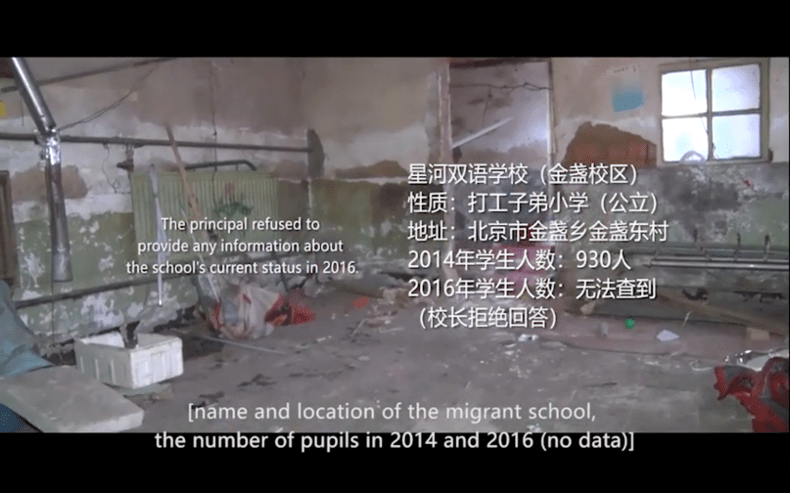
Migrant Workers Home in Picun engages many residents, communities, authorities directly and indirectly with long term projects. To avoid a controlled and homogeneous narrative of the organization by its leaders like Wang Dezhi, we held interviews with people like Xiaojing, a former volunteer of the organization, to illustrate how the Migrant Workers Home and Picun have developed or changed with a local resident and volunteer instead of leaders, a perspective of nearby. Speaking nearby stems from Trinh’s philosophy of indirectness: “One can only approach things indirectly. Because, in doing so, one not only goes toward the object of one’s focus without killing it, but one also allows oneself to get acquainted with the envelope, that is, all the elements which surround, situate or simply relate to it.” [35] Our discussion with Xiaojing has been less divisive, paying more attention to the seeming trifles such as working conditions at the warehouse of Tongxin Mutual Aid Charity Store, sexual harassment incidents in the organization, sexuality of migrant workers, and prostitution in Picun. Although Xiaojing’s account of stories in Picun do not directly speak about the Migrant Workers Home, we do not dismiss them as inessential or deceptive. Instead, we acknowledge them as the “attention to surface as a practice of critical description,” [36] whose depth is “continuous with surface and is thus an effect of immanence.” [37] His account illustrates Picun as a nearby that the Migrant Workers Home situates in and their mutual influence or non-influence.
In the discussion with Xiaojing, we talked about the pit latrine, a toilet structure in Picun, as he wrote “Next to the ping pong table, the racket slipped inadvertently, and the ping pong ball fell near the pit. No one picked it up. That is its corpse.” [38] Xiaojing was once asked to clean the toilet and told by a leader of the Migrant Workers Home that Chairman Mao once said young people need to go up to the mountains and down to the countryside and receive education amongst the people. However, he cannot agree with this kind of revolutionary discourse, such as repression, subjectivity, and other big words. Trinh states that poetic language is fundamentally reflexive and can deal with meaning in a revolutionary way. [39] Writing against the revolutionary discourse, Xiaojing uses metaphorical language to reflect on the gap between Migrant Workers Home’s mission and the reality, the public governance of local government, and the dignity of migrant workers. For Xiaojing, the Migrant Workers Home is far away from the great utopia of the emancipation of the working class since the organization itself cannot erase injustice or generate any ideological influence on the nearby. It is necessary for the Migrant Workers Home to think about how to unite with the younger generations of workers through languages beyond the homogeneous and orthodox revolutionary discourse.
To open more space beyond the discourse, Yin Siyuan, a scholar of communication, argues that many people related to the Migrant Workers Home are “maofen (毛粉, fans of Mao Zedong),” who have a kind of “socialist nostalgia” or “romanticize” that period and the discourse of orthodox Marxism that prioritizes the issue of social class but marginalizes others such as gender. Since capitalism adopts patriarchy, the study needs an intersectional perspective. In 2016, two former female members of the New Workers Band founded the jiuye yuedui (九野乐队, Jiuye Band), an independent folk music band of four female activists who advocate gender equality especially among female migrant workers. This organization takes flexible forms of organizing because unlike the New Workers Band and the Migrant Workers Home whose male core members can work full-time for the organizations, members of the Jiuye are housewives, migrant workers, and students who have limited spare time and finical resources for cultural and activistic activities. Also, Jiuye still maintains a close relationship with the New Workers Band and often participates in their events. Jiuye’s musical works tend to “go beyond class differences and address women’s gendered experiences in general,” which construct a nearby for all feminist activism beyond homogeneous and orthodox discourse of socialist revolution. [40]
While acknowledging that we scholars do capitalize on the under-privileged migrant workers of the Migrant Workers Home and the New Workers Band to accomplish our research, Yin also claims that there are still some kinds of engagement we can do, like conducting research, making donations, and informing the next generations through teaching. As all kinds of resistance and fights for equality, freedom, and liberation will still exist in the future, the closures of speaking nearby (interviews and conversations of this issue) “are only moments of transition opening up to other possible moments of transition.” [41]
A Future Nearby
We are working on this issue at the intersection of the New Worker Band’s 20th anniversary and the Chinese Communist Party’s 20th National Congress, witnessing an increasingly authoritarian power. During the pandemic lockdown, many migrant workers left Picun, and activities of the Migrant Workers Home moved online or were suspended. On International Workers’ Day 2022, the New Worker Band announced that the band had changed its name to gucang yuedui (谷仓乐队, Barn Band). They now tour around the country to visit rural areas and write cunge (村歌, village songs) because the central government’s focus on rural reconstruction (乡村建设) and rural revitalization (乡村振兴) in recent year’s policies. After the demolition of the Culture and Art Museum of Migrant Workers, the Migrant Workers Home has had to face another displacement after eighteen years of settlement in Picun. It seems that the organizations and Picun bear the critique that they are not able to mobilize the mass to emancipate the working class. However, this kind of critique is essentially problematic because it is fixed on “immediate situations” and an “orientation to a very long-term horizon” as the great emancipation is too far away for the Migrant Workers Home, Picun, or any socially engaged art project.[42] Since the pandemic and lockdowns are basically over, Wang Dezhi is optimistic about future policy and actively looking for new possible venues for the museum. And recently, a virtual version of the Culture and Art Museum of Migrant Workers was live.[43] A future nearby is the horizon where concrete sociality emerges and consequential collective actions can be taken, bringing new imaginations. We should not be too obsessed with the very far or the very near but focus more on the nearby, in terms of not only social class but also gender, race, and ethnicity in the writing of socially engaged art criticism.
Yuxiang Dong
Yuxiang Dong is an art, educational, and social worker. His articles have been published in Leonardo, Media-N, Photographis, and other journals. He has taught at the University of Illinois Urbana-Champaign, University of Cincinnati, Virginia Commonwealth University, and other institutions.
Notes
[1] Official statistical data is difficult to find, but these numbers from research essays and journalistic articles should provide an overall impression about Picun’s population. See Fei Liu, “Pi Village, with Occasional Music: Notes on the New Workers Art Troupe,” Inter-Asia Cultural Studies 19, no. 3 (2018): 419–30; Wang Chuanhui, “Zaifang Picun (再访皮村),” Ifeng, last modified September 14, 2016, http://inews.ifeng.com/49967306/news.shtml.
[2] Biao Xiang, “The Nearby: A Scope of Seeing,” Journal of Contemporary Chinese Art 8, no. 2 & 3 (2021): 147–165.
[3] Reassemblage: From the Firelight to the Screen, directed by Trinh T. Minh-ha (Women Make Movies, 1982), 40:00.
[4] Recent English scholarship on the Migrant Workers Home’s music works, writings, and other forms of social and cultural practices that follow this trend of analysis include: Chun Chun Ting, “The ‘Unlikely Writers’ from Picun: Reinventing Literature and Politics at the Migrant Workers Home” positions: asia critique 31, no. 2 (2023): 333–355; Yurou Zhong, “Musica Practica: The Sound of the Beijing New Worker Band,” positions: asia critique 31, no. 2 (2023): 281–301; Siyuan Yin, “Cultural production in the working-class resistance: labour activism, gender politics, and solidarities,” Cultural Studies 34, no.3 (2020): 418–441; and Bo Zheng, “Workers of the World, United!,” in Comintern Aesthetics, eds. Amelia M. Glaser and Steven S. Lee (Toronto: University of Toronto Press, 2020), 505–528.
[5] Hui Wang, “Two kinds of new poor and their future: the decline and re-shaping of class politics and the politics of dignity of the new poor (两种新穷人及其未来——阶级政治的衰落、再形成与新穷人的尊严政治),” Kaifang shidai (开放时代), no. 6 (2014): 53.
[6] Claire Bishop, Artificial Hells: Participatory Art and the Politics of Spectatorship (London and New York: Verso, 2011), 6.
[7] Xiang, “The Nearby,” 147.
[8] Xiang, “The Nearby,” 147.
[9] See: Yuxiang Dong, Wei Wu, Xiaojing, and Yanhua Zhou, “Stories of Picun: Interview with Xiaojing” FIELD: A Journal of Socially-Engaged Art Criticism, Issue 26 (Winter 2024), https://field-journal.com/issue-26/stories-of-picun-interview-with-xiaojing.
[10] See: Yuxiang Dong, Song Yi, and Yanhua Zhou, “New Workers’ Video Collective: Interview with Song Yi”, FIELD: A Journal of Socially-Engaged Art Criticism, Issue 26 (Winter 2024), https://field-journal.com/?p=7672.
[11] Michael Warner, Publics and Counterpublics (New York: Zone Books, 2005).
[12] Xiang, “The Nearby,” 150.
[13] For example, in our interview with Xiaojing, he states that he came to Picun with the intention to write about the Migrant Workers Home and participate in their activities while working on temporary jobs. See: Yuxiang Dong, Wei Wu, Xiaojing, and Yanhua Zhou, “Stories of Picun: Interview with Xiaojing” FIELD: A Journal of Socially-Engaged Art Criticism, Issue 26 (Winter 2024), https://field-journal.com/issue-26/stories-of-picun-interview-with-xiaojing.
[14] Jia Kuo, “‘Migrant Workers Home and Its Practices on Shaping the Culture and Community of ‘New Working Class’: A Criticism on Cultural-political Activism in Contemporary China,” Cultural Studies 31, no.6 (2017), 966.
[15] In our interview with Wang Dezhi, he states that the national and ministerial level governments agree with their works strongly. See: Wang Dezhi, Yuxiang Dong, and Yanhua Zhou “The Past, Present, and Future: Interview with Wang Dezhi” FIELD: A Journal of Socially-Engaged Art Criticism, Issue 26 (Winter 2024), https://field-journal.com/editorial/the-past-present-and-future-interview-with-wang-dezhi.
[16] Churan Zheng, “Rolling Brainwashing Machine: The incidents of Jia Zhiwei’s Sexual Assault and Harassment of Female Volunteers (滚筒洗脑机 | 贾志伟性侵性骚扰女志愿者事件),” China Digital Times, last modified January 17, 2019, https://chinadigitaltimes.net/chinese/604071.html.
[17] Fredric Jameson, The Political Unconscious: Narrative As A Socially Symbolic Act (Ithaca: Cornell University Press, 1981), 60.
[18] Qiang Du, “The Vagabond Club,” True Story Award, accessed September 15, 2023, https://truestoryaward.org/story/57#:~:text=The%20%E2%80%9 CSanhe%20gods%E2%80%9D%20are%20a,days%20in%20an%20internet%20caf%C3%A9.
[19] Stephen Best and Sharon Marcus, “Surface Reading: An Introduction,” Representations 108, no. 1 (2009): 1.
[20] Best and Marcus, “Surface Reading,” 9.
[21] Sarah Pink, Doing Sensory Ethnography (London and Thousand Oaks: SAGE Publications Ltd, 2015).
[22] Ling Kang, The Left-Wing with Sound: Body Politics of Poetry Recitation and Revolutionary Literature and Art (有声的左翼: 诗朗诵与革命文艺的身体技术) (Shanghai: Shanghai Literature and Art Publishing House, 2020).
[23] See: Wang Dezhi, Yuxiang Dong, and Yanhua Zhou “The Past, Present, and Future: Interview with Wang Dezhi” FIELD: A Journal of Socially-Engaged Art Criticism, Issue 26 (Winter 2024), https://field-journal.com/editorial/the-past-present-and-future-interview-with-wang-dezhi. See: Yuxiang Dong, Song Yi, and Yanhua Zhou, “New Workers’ Video Collective: Interview with Song Yi”, FIELD: A Journal of Socially-Engaged Art Criticism, Issue 26 (Winter 2024), https://field-journal.com/?p=7672.
[24] Xiang, “The Nearby,” 147.
[25] Xiang, “The Nearby,” 147.
[26] Wang Dezhi and Chun Chun Ting, “How to Create a New Workers’ Culture Together: An Interview with Wang Dezhi,” ed. Chun Chun Ting, trans. Max Bohnenkamp, positions: asia critique 31, no.2 (2023): 507–521 and Christopher Connery, “New Workers’ Culture: An Interview with Xu Duo,” Boundary 2 46, no. 2 (2019): 255–62.
[27] See: Wang Dezhi, Yuxiang Dong, and Yanhua Zhou “The Past, Present, and Future: Interview with Wang Dezhi” FIELD: A Journal of Socially-Engaged Art Criticism, Issue 26 (Winter 2024), https://field-journal.com/editorial/the-past-present-and-future-interview-with-wang-dezhi.
[28] Reassemblage, 01:28 to 01:35.
[29] Nancy N. Chen, “‘Speaking Nearby:’ A Conversation with Trinh T. Minh-ha,” Visual Anthropology Review 8, no.1 (1992): 87.
[30] Chen, “‘Speaking Nearby’,” 87.
[31] Xiaoyi Nie, “From Curating to Cedong: Long March: A Walking Visual Display and the Emergence of Contemporary Chinese Curating” (PhD Thesis, Royal College of Art, 2022).
[32] Lily Chumley, Creativity Class: Art School and Culture Work in Postsocialist China (Princeton & Oxford: Princeton University Press, 2016), 20.
[33] See TightBelt “MeToo Submission: Investigation into the Long-Term Sexual Harassment Problem of Shanghai-Based Photographer Surnamed Dai (MeToo投稿 | 关于上海戴姓摄影师长期性骚扰问题的调查),” weixin.qq.com, last modified June 24, 2023, https://mp.weixin.qq.com/s/t29v-2whnGdHNuxZ64MPJA; Art Minesweeper, “Long Story: What Exactly Is Being Triggered by the Self-Media Platform Fueled by Young Artists? (长篇|以年轻艺术家为燃料的自媒体平台,究竟在触发什么?),” weixin.qq.com, last modified April 6, 2021, https://mp.weixin.qq.com/s/OJagZh3jAWgZx0uuCY_7Ig; Xinhao Cheng, “Artists as Laborers: Our Labors Need Payments (作为劳动者的艺术家——我们的劳动需要报酬),” weixin.qq.com, last modified January 6, 2020, https://mp.weixin.qq.com/s/3KuBcqCB8dbhIKKVOoFHzg; Qingmei Yao, “The Absence of Artists Fee (空缺的艺术家费用),” weixin.qq.com, last modified January 2, 2020, https://mp.weixin.qq.com/s/sFpzy1AkdLBLiHYltvGQag; UnitedMotion, “An Industry without Norms, How Artists Should Respond: A Case of the Jimei x Arles International Photo Festival (行业失范已成常态,艺术家该如何应对——以集美阿尔勒摄影季为例),” weixin.qq.com, last modified December 6, 2019, https://mp.weixin.qq.com/s/XOxlNCth1a-7f12VLLJK4A.
[34] Khadidiatou Gueye, “Ethnocultural Voices and African Aesthetics in Trinh Minh-ha’s ‘Reassemblage: From the Firelight to the Screen’,” Research in African Literatures 39, no. 3 (2008): 16.
[35] Annamaria Morelli, “The Undone Interval,” in The Post-Colonial Question: Common Skies, Divided Horizons, eds. Iain Chambers and Lidia Curti (New York: Routledge), 4.
[36] Best and Marcus, “Surface Reading,” 11.
[37] Best and Marcus, “Surface Reading,” 11.
[38] Xiao Jing, “Thoughts about the Toilet (关于厕所的思考),” weixin.qq.com, last modified May 18, 2019, https://mp.weixin.qq.com/s/RE6kfy8EEzY6UjNT5KjLOg.
[39] Chen, “‘Speaking Nearby’,” 86.
[40] Siyuan Yin, “Cultural production,” 435.
[41] Chen, “‘Speaking Nearby’,” 87.
[42] Jane Guyer, “Prophecy and the near future: Thoughts on macroeconomic, evangelical, and punctuated time,” American Ethnologist 34, no.3 (2007): 409–421.
[43] New Culture and Art Museum of Migrant Workers, accessed January 19, 2024, https://the-culture-and-arts-museum-of-migrant-labors.com/.

